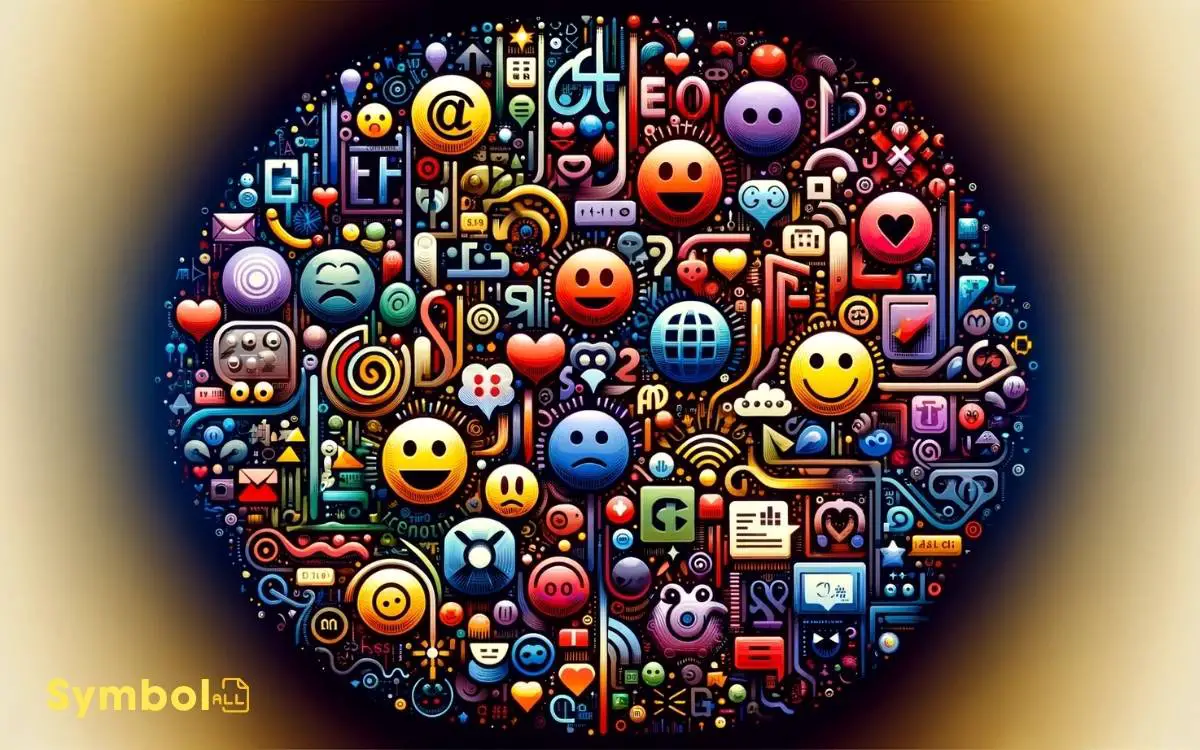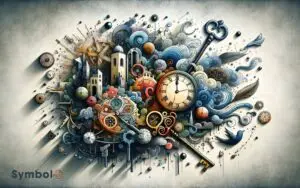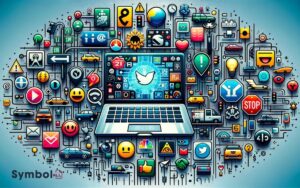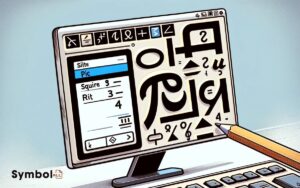Symbols Used in Text Messages: Decoding Common Emojis!
In text messaging, you navigate a rich tapestry of symbols, each conveying unique sentiments and ideas.
Early character limits propelled the creation of abbreviated expressions, evolving into a complex lexicon, including emoticons, emojis, ASCII art, and nuanced punctuation. Emoticons and emojis bridge emotional gaps, while ASCII art demonstrates creativity within constraints.
Punctuation, beyond its grammatical role, subtly conveys emotions, indicating sarcasm or affection with precise economy. This linguistic adaptation reflects humanity’s ingenuity in maximizing digital communication potential.
Exploring these symbols offers insights into human creativity amid technological constraints, promising a deeper appreciation of digital discourse’s subtleties.

Key Takeaways
15 Common Text Messaging Symbols and Their Meanings
| Symbol | Meaning | Usage Example |
|---|---|---|
| 🙂 | Happy/Smiley Face | I passed my exam 🙂 |
| 🙁 | Sad/Frowny Face | I lost my keys 🙁 |
| 😀 | Big Smile/Laughing | That joke was funny 😀 |
| 😉 | Wink | See you later 😉 |
| 😛 | Sticking Tongue Out (playful) | You can’t catch me 😛 |
| :/ | Skeptical/Undecided | I don’t know about that :/ |
| :O | Surprise/Shock | You did what? :O |
| <3 | Love/Heart | I love you <3 |
| XD | Laughing with eyes closed | That was hilarious XD |
| >:( | Angry/Annoyed Face | That’s not fair >:( |
| :'( | Crying/Sad | I’m so sad about this :'( |
| : | Neutral/Indifferent Face | |
| O:) | Angel/Innocent | I did nothing wrong O:) |
| -_- | Annoyed/Irritated | That’s enough from you -_- |
| 8) | Cool (wearing sunglasses) | No worries, I got this 8) |
The Evolution of Texting Symbols
The evolution of texting symbols reflects a dynamic intersection of technology and language, adapting to the constraints and possibilities of digital communication.
Initially, texting’s brevity was necessitated by the character limits of early mobile technology, compelling users to abbreviate expressions and concepts.
As digital platforms evolved, so did the lexicon of texting symbols, expanding to include a vast array of signs that convey emotions, actions, and complex ideas with remarkable economy.
This linguistic adaptation showcases the human capacity to innovate within restrictive mediums, transforming limitations into a rich, nuanced form of expression.
You’re witnessing a linguistic evolution, where symbols become increasingly integral to digital discourse, embodying an intricate dance between technological advancement and the innate human desire for connection and expression.
Understanding Emoticons
Building on the linguistic evolution highlighted previously, understanding emoticons is key to grasping how digital communication has been enriched by these expressive symbols.
Emoticons, a blend of emotion and icon, serve as a pivotal tool in conveying sentiment and nuance in text-based messages. Their creation and widespread adoption underscore the human need to infuse digital communication with personal touch and emotional depth.
Here are three critical aspects to consider:
- Historical Context: Emoticons originated in the 1980s, evolving from simple character combinations to complex representations of facial expressions.
- Functionality: They bridge the emotional gap in text conversations, offering a surrogate for non-verbal cues.
- Cultural Variations: Emoticons can carry different meanings across cultures, necessitating a nuanced understanding to avoid misinterpretation.
This exploration reveals the intricate role emoticons play in enhancing digital dialogue.
The Rise of Emoji
In the digital age, emojis have emerged as a sophisticated extension of emoticons, transforming the landscape of online communication with their rich, visual language.
Unlike their predecessors, emojis offer a vast array of symbols, from facial expressions to common objects, allowing users to convey emotions, activities, and ideas with unprecedented precision and flair. This evolution stands in stark contrast to the early days of digital communication, where users had to make emojis using symbols like colons, parentheses, and dashes to create rudimentary smileys. Now, with thousands of vibrant options, emojis have become a universal language that transcends cultural and linguistic boundaries. They enable users to add a personal touch to their messages, making digital interactions more engaging and expressive.
This evolution reflects a broader trend towards visually oriented communication, enabling individuals to express subtleties and nuances that text alone might miss.
The integration of emojis into major digital platforms has cemented their status as a universal language, transcending cultural and linguistic barriers.
Their rise underscores a shift in digital expression, highlighting the growing importance of visual literacy in the age of instant messaging and social media.
ASCII Art in Texting
You must understand that ASCII art in texting, originating from the early computer era, employs simple characters from the ASCII standard to create intricate visuals.
These popular symbols, ranging from emotive faces to complex landscapes, showcase the versatility and creativity inherent in text-based communication.
Furthermore, creating personalized ASCII art allows for a unique form of expression within the constraints of digital text, reflecting individual creativity and technological ingenuity.
Origins of ASCII Art
The origins of ASCII art, a method of creating images through the arrangement of characters on a keyboard, can be traced back to the early computer era, revolutionizing the way we express creativity in digital communication.
You’ll find its roots deeply embedded in the limitations and innovations of early computing.
- Teleprinters Era: Before personal computers, ASCII art emerged on teleprinters, which could only convey text.
- Early Internet Forums: ASCII art gained popularity in the 1980s on bulletin board systems (BBS), where users shared creations within text-only constraints.
- Digital Expression: It transformed into a unique digital art form, allowing for intricate designs using simple characters.
This evolution underscores a blend of technical limitation and creative liberation, marking ASCII art as a significant cultural artifact in the digital communication landscape.
Popular ASCII Symbols
As we delve into the realm of ASCII art within texting, it’s crucial to recognize the popular symbols that have become staples of digital expression.
These symbols, crafted from the ASCII standard, provide a means to convey emotion, humor, and intricate ideas within the constraints of text-based communication.
Their usage not only enhances the clarity of messages but also enriches the texting culture with a unique form of creativity. Below is a table showcasing some prevalent ASCII art symbols:
| Symbol | Description | Usage |
|---|---|---|
| 🙂 | Smiley Face | Happiness, joy |
| 🙁 | Sad Face | Sadness, displeasure |
| <3 | Heart | Love, affection |
| 😛 | Tongue Out | Playfulness, teasing |
This table outlines a mere fraction of the vast repertoire available, illustrating the diversity and adaptability of ASCII art in digital communication.
Creating Personalized ASCII
Harnessing the versatility of ASCII art for personalized messaging transforms simple texts into unique expressions of individuality. When you embark on creating personalized ASCII, you’re engaging in a process that blends technical skill with artistic vision.
Here are steps to guide you:
- Understand the Basics: Familiarize yourself with ASCII characters and their spatial relationships. This foundational knowledge is critical for crafting coherent and visually appealing designs.
- Sketch Your Idea: Start with a conceptual sketch. Planning your design on paper helps in visualizing the end product and simplifies the translation process into ASCII characters.
- Experiment and Refine: ASCII art creation involves trial and error. Adjust spacing, experiment with different characters, and refine your design to achieve the desired aesthetic.
Through this analytical approach, you’re not just sending a message; you’re delivering a piece of personalized digital artistry.
Punctuation Marks With Hidden Meanings
You must recognize that punctuation marks in text messages often carry meanings beyond their traditional grammatical roles.
For instance, they can serve as emotional tone indicators, subtly conveying feelings like joy or frustration.
Similarly, they’re pivotal in signaling sarcasm or irony, thereby enriching the text’s interpretive layers.
Emotional Tone Indicators
Many people don’t realize that certain punctuation marks can subtly convey a wide range of emotional tones in text messages, serving as hidden indicators of the sender’s feelings. These symbols, when analyzed, reveal nuanced layers of communication.
Here are three key emotional tone indicators:
- The ellipsis (…): Often signifies a pause, hesitation, or trailing off in thought, suggesting uncertainty or contemplation.
- The exclamation mark (!): Indicates excitement, enthusiasm, or surprise. Its presence can drastically alter the perceived emotional tone of a message.
- The combination of question mark and exclamation mark (?! or !?): This conveys a tone of disbelief or amazement, blending inquiry with an emotional charge.
Understanding these symbols enriches your interpretation of text messages, allowing for a deeper appreciation of the sender’s emotional state.
Sarcasm and Irony Signals
In the realm of text messaging, certain punctuation marks serve as subtle indicators of sarcasm and irony, offering a layer of meaning beyond the literal text.
These symbols, when skillfully deployed, allow you to convey nuanced emotional tones that might otherwise be lost in digital communication.
Understanding and using these signals can greatly enhance the clarity and depth of your textual interactions.
| Symbol | Name | Function |
|---|---|---|
| /s | Sarcasm Slash | Indicates the preceding text is sarcastic. |
| (!) | Irony Mark | Suggests the text should be read with irony. |
| … | Ellipsis | Implies a trailing off or an unstated sarcasm. |
| ~ | Tilde | Often used to denote playfulness or irony. |
These markers, when woven into your messages, enrich your digital dialogue by allowing for expressions of irony and sarcasm that might otherwise be misinterpreted.
The Language of Abbreviations
Abbreviations form a compact language, allowing for efficient and rapid communication in text messages. This linguistic phenomenon has evolved as a response to the constraints of digital communication and the human desire for brevity.
To grasp its utility, consider these facets:
- Economy of Language: Abbreviations reduce the time and space required for expression, enabling quicker exchanges.
- Semantic Precision: Despite their brevity, well-established abbreviations convey specific meanings unambiguously, thanks to their widespread recognition.
- Cultural Significance: They reflect the dynamics of digital culture, encapsulating common expressions and sentiments in condensed forms.
Understanding these aspects enlightens you on the practicality and richness of abbreviated language, positioning you to navigate digital conversations with greater fluency and insight.
Number and Letter Combinations
You’ll find that number and letter combinations in text messages often serve as common text abbreviations, a phenomenon that necessitates an analytical examination.
Deciphering these numeric codes requires an understanding of their origins and applications within digital communication.
This exploration will illuminate how such combinations streamline messaging while preserving the essence of the communication.
Common Text Abbreviations
Many text abbreviations blend numbers and letters to create concise expressions that convey messages quickly and efficiently.
These combinations serve as shorthand in digital communication, allowing users to express complex ideas or emotions succinctly. As you navigate through the landscape of text messaging, understanding these abbreviations is crucial.
Here are three common examples:
- B4 – This abbreviation stands for ‘Before.’ It utilizes the numeral ‘4’ to phonetically replace the word ‘for,’ streamlining communication.
- GR8 – Representing the word ‘Great,’ this abbreviation combines the letter ‘G’ with the phonetic sound of ‘R8,’ symbolizing the syllable ‘rate.’
- 2F4U – Meaning ‘Too Fast For You,’ this abbreviation cleverly uses numbers to convey speed and agility in response or action.
Each of these examples demonstrates the efficiency of combining letters and numbers to communicate effectively in the digital era.
Deciphering Numeric Codes
In exploring the intricate landscape of digital communication, it’s essential to understand how numeric codes, those clever combinations of numbers and letters, function as a versatile tool for conveying complex messages efficiently.
These codes bridge linguistic nuances and cultural boundaries, providing a compact method for expressing emotions, intentions, and information. You’ll find that deciphering these codes isn’t merely about recognizing individual characters but grasping their collective significance.
Each combination, whether it’s ‘143’ signifying ‘I love you’ or ‘404’ denoting ‘clueless’, encapsulates a broader narrative within a minimalistic format.
Mastery of these codes enhances your digital literacy, enabling you to navigate the nuanced realms of text-based communication with an informed perspective.
This knowledge not only streamlines your interactions but also enriches your understanding of digital culture’s evolving lexicon.
Cultural Variations of Symbols
Symbols in text messages often exhibit significant cultural variations, reflecting the diverse ways in which societies communicate nonverbally.
You’ll find that the same symbol can convey different meanings across cultures, underscoring the importance of context in digital communication.
- Emoticons: While a smiley face 🙂 is universally recognized, variations like the Japanese kaomoji (^_^) convey emotions through intricate facial expressions, incorporating cultural nuances.
- Punctuation: The use of periods can imply formality or anger in certain Western cultures, whereas in others, it’s merely a grammatical necessity, devoid of emotional weight.
- Color Symbols: In text messaging, color emojis are loaded with meanings. Red can signify luck and prosperity in China, while in South Africa, it might be associated with mourning.
Understanding these variations is crucial for effective cross-cultural communication in our globalized digital world.
Symbols for Flirting and Affection
Text message symbols for flirting and affection subtly convey romantic interest and emotional closeness, often utilizing familiar icons in novel ways. The heart emoji, in its various colors, is a prime example, symbolizing love and adoration.
However, the nuances of flirting extend beyond this. A wink face (;)) implies playfulness, suggesting a light-hearted, flirtatious intent. The use of the peach or eggplant emoji often carries sexual connotations, demonstrating how symbols can communicate desire indirectly.
Sequences of emojis, like a smiley face followed by a series of hearts, can indicate escalating affection. Analyzing these symbols reveals a complex language of digital flirtation, where meanings are context-dependent and evolve with societal norms.
Understanding this lexicon requires not just familiarity but also sensitivity to the subtleties of digital communication.
Texting Symbols for Anger and Frustration
Exploring the realm of digital communication, one finds that certain emojis and characters effectively express anger and frustration, providing a nuanced language for these intense emotions.
These symbols serve as a concise means to convey feelings that might be cumbersome to articulate through text alone.
To enhance your understanding, consider the following:
- Angry Face Emoji (�): This universally recognized symbol succinctly captures the essence of anger, often used to indicate displeasure or disagreement.
- Steam From Nose Emoji (�): Symbolizing frustration or suppressed rage, this emoji conveys the feeling of being fed up or exasperated with a situation or person.
- Capital Letters: Utilizing ALL CAPS in a message can signify shouting, thereby expressing heightened anger or frustration.
These elements of digital communication offer a rich vocabulary for expressing complex emotional states succinctly.
Humorous and Sarcastic Symbols
You must recognize that humor and sarcasm in text messages often rely on the strategic use of emojis and punctuation. By crafting witty emojis, you convey nuanced emotions and thoughts that text alone can’t fully capture.
Similarly, sarcasm through punctuation, such as using a series of question marks or an unexpected exclamation point, can subtly alter the tone, adding layers of meaning to your messages.
Crafting Witty Emojis
Crafting witty emojis, those humorous and sarcastic symbols, requires a nuanced understanding of digital communication’s subtleties and the audience’s cultural context.
To excel in this art form, you must:
- Grasp Emoji Connotations: Understand the layers of meaning behind each emoji. A peach isn’t just a fruit in the digital realm; it carries additional, often humorous or suggestive, connotations.
- Combine Emojis Creatively: Pair emojis in unexpected ways to convey complex ideas or jokes. A snowflake and a fire emoji together might denote ‘cold yet spicy’ humor.
- Stay Updated: Emoji meanings evolve. What was once innocent may now carry a sarcastic undertone. Staying informed of these shifts ensures your emoji usage remains relevant and humorous.
Mastering these aspects allows you to communicate with precision, leveraging emojis not just as decoration but as a sophisticated, witty language in text messaging.
Sarcasm Through Punctuation
Delving into the realm of digital communication, it’s crucial to recognize how punctuation marks, often overlooked, serve as powerful tools for injecting sarcasm and humor into text messages.
The strategic use of a single punctuation mark can dramatically alter the tone of a message, conveying sarcasm without the need for explicit explanation.
For instance, the seemingly innocuous period can transform a simple statement into a subtle jab, indicating a dry, understated humor.
Similarly, quotation marks can suggest irony or disbelief, subtly questioning the sincerity of the enclosed statement. Moreover, the ellipsis, by suggesting an unfinished thought or a deliberate pause, can introduce an element of suspense or imply skepticism.
Understanding these nuances allows you to convey complex tones of voice, such as sarcasm, with precision, enhancing your digital communication skills.
Symbols in Professional Communication
In professional communication, incorporating symbols can significantly enhance clarity and efficiency, provided they’re employed judiciously.
Symbols, when used appropriately, convey complex ideas succinctly, saving time while ensuring the message is understood.
However, the key lies in understanding which symbols are appropriate and how they’re interpreted within a professional context.
Here are three essential points to consider:
- Currency Symbols: Instantly convey financial information, crucial in business transactions and financial reports.
- Mathematical Symbols: Aid in presenting data analysis, projections, and statistical information clearly and concisely.
- Bullet Points: Organize information in lists, making it easier to scan and understand priorities or action items.
These symbols, when used effectively, can transform dense, complex messages into digestible, actionable information, facilitating smoother communication in professional settings.
The Impact of Memes in Texting
Memes, when shared through texting, significantly shape and redefine interpersonal communication dynamics.
They serve as a novel conduit for conveying emotions, reactions, and shared cultural references, often more succinctly than words alone could achieve.
This evolution in texting behavior underscores a shift towards a more visually oriented language, where meaning is layered and multifaceted.
You’ll find that memes, by their very nature, encapsulate complex ideas and emotions in a single, easily shareable image or phrase, fostering a unique form of empathy and understanding between individuals.
They enable you to communicate nuances of feeling and shared cultural experiences with a speed and efficiency that traditional text-based messages may lack.
Consequently, memes have become an indispensable tool in the modern lexicon of texting, enhancing and enriching digital communication.
Creating Personalized Symbols
Creating personalized symbols offers a unique avenue for individuals to encapsulate their identity and emotions in a nuanced, yet universally comprehensible, manner.
This process involves:
- Identification of Unique Elements: You first identify personal traits, experiences, or emotions that you wish to represent through symbols. This step is crucial for ensuring the symbols are meaningful and reflective of your individuality.
- Designing the Symbol: Next, you design a symbol that encapsulates these elements. This may involve combining existing symbols or creating new ones from scratch, aiming for simplicity and recognizability.
- Integration and Usage: Lastly, you integrate these personalized symbols into your text messages. Over time, they become part of your digital vocabulary, allowing for more expressive and nuanced communication.
This method enhances the depth and personalization of digital interactions, making each conversation more meaningful.
The Future of Texting Symbols
Building upon the foundation of personalized symbols, the future of texting symbols promises to revolutionize how we communicate digitally, making interactions increasingly expressive and nuanced.
This evolution will likely be characterized by the integration of AI-driven technologies, enabling the creation of highly adaptive and context-sensitive symbols.
| Era | Key Features |
|---|---|
| Past | Static, universally understood |
| Present | Personalized, diverse |
| Future | Adaptive, context-sensitive |
This transition signifies a shift towards a more intuitive and personalized digital communication landscape, where symbols can adjust in real-time to convey subtleties of emotion and intent more accurately.
The implementation of these advanced symbols will necessitate a sophisticated understanding of semantics, cultural nuances, and user preferences, underscoring the importance of interdisciplinary research in linguistics, psychology, and computer science.
Conclusion
The landscape of text messaging has evolved significantly, with symbols transforming from simple emoticons to complex emojis and ASCII art.
As you navigate this digital terrain, remember, ‘a picture is worth a thousand words,’ making these symbols a powerful tool in concise communication.
Whether in casual chats or professional contexts, the strategic use of these symbols can enhance clarity and convey emotions precisely.
As we look to the future, personalized symbols and memes promise to further enrich our texting lexicon, embodying the dynamic interplay between technology and human expression.






